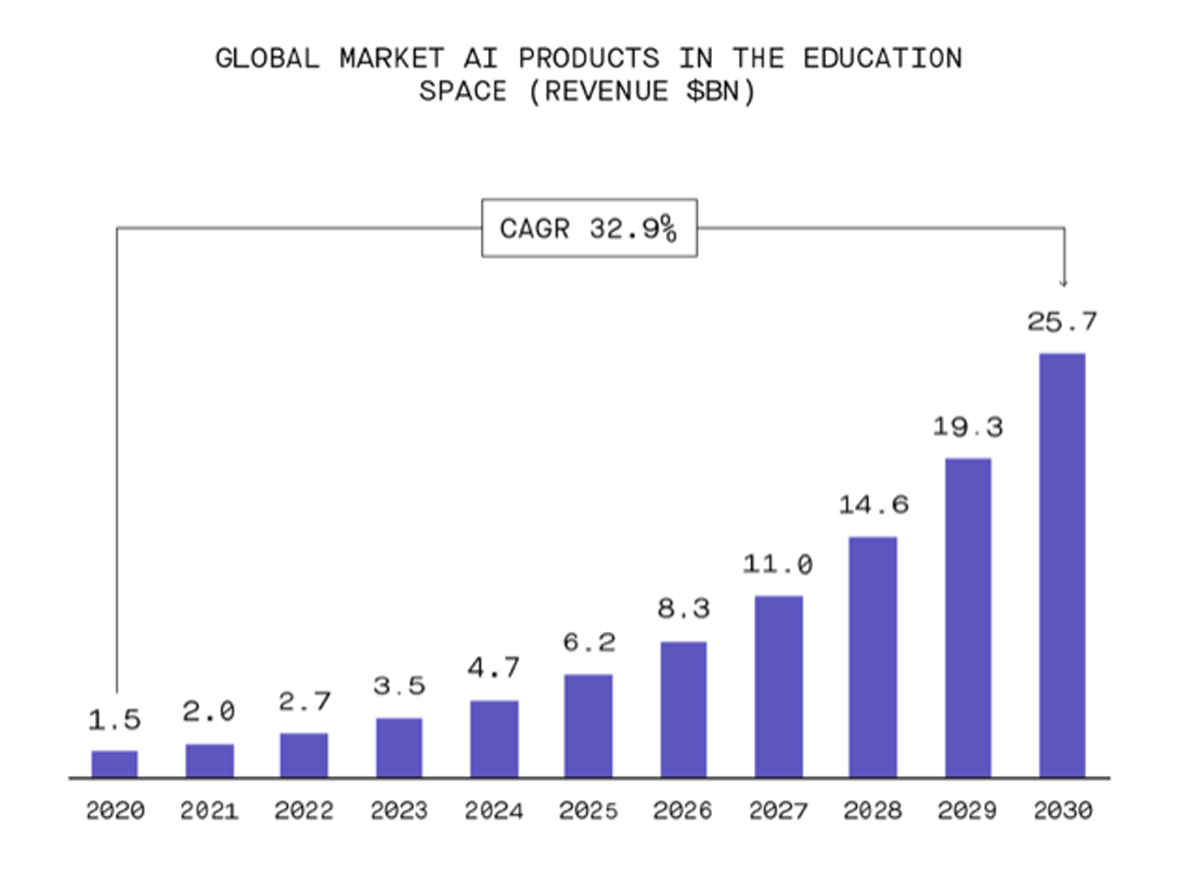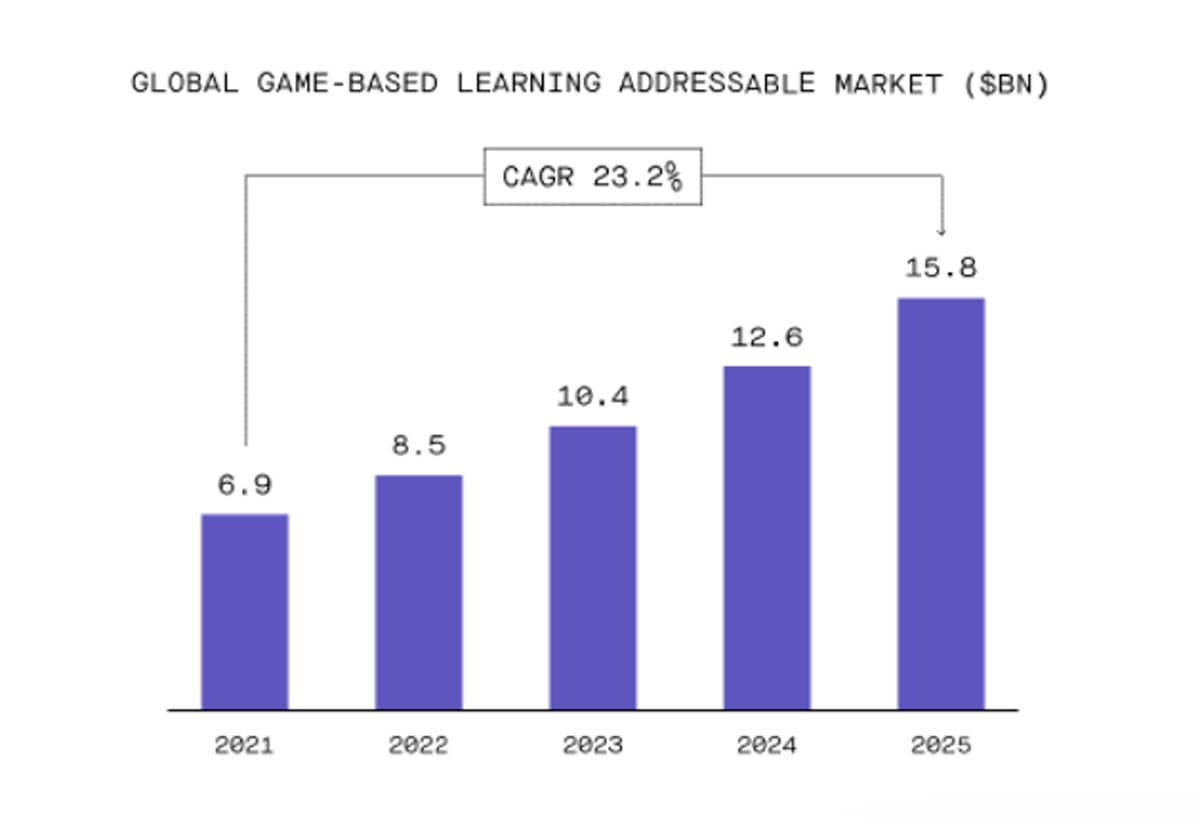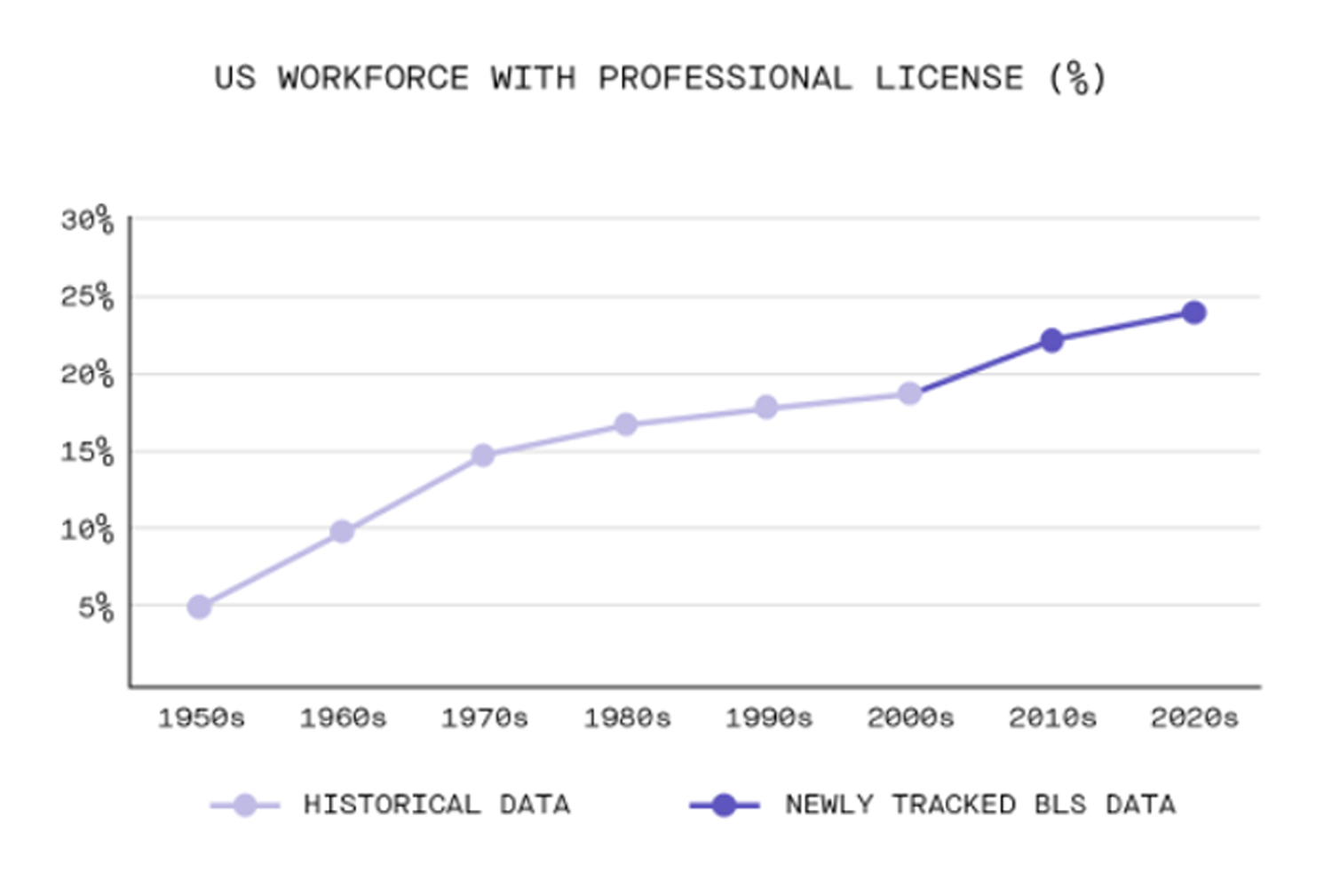The concept of ‘classroom education’ has radically changed since the pandemic. Accelerated by nationwide school closures during 2020, schools were challenged with combinations of in-person, hybrid, and remote learning models. Teachers had to adapt to unexpected conditions and teaching in unprecedented ways.
Technologies such as Artificial Intelligence, Virtual Reality and Augmented Reality have expanded teaching options in the education industry, providing opportunities for learners far outside the reach of the traditional classroom. EdTech is now at the head of the class offering promising learning experiences with seamless integration of teacher-student communication. In fact, education technology is at an inflection point – global EdTech digital spending is already over $250bn and is expected to reach $600bn+ by 2027. Growth drivers in EdTech will undoubtedly continue to thrive for the near future, benefiting from demonstrable value and growing recognition of the mission critical nature of innovation, improvement, and optimization to maximize learning outcomes. These transformations will be especially important in the coming years for school districts that are now working to leverage the lessons learned during the Pandemic-era. These technologies will be used to optimize the learning experience in both remote and in-person settings through both synchronous and asynchronous learning modalities.
By giving students the ability to practice self-sufficiency and time management skills, asynchronous learning allows them to adopt a more direct, hands-on role in their education.
Here’s a look at some of the top trends impacting the future of education and how educators and learners across the education ecosystem can be well prepared for the exciting advancements taking place in education technology.
Asynchronous learning
Asynchronous learning has quickly risen as a staple in formal education. After a remote setting became the only viable option during the global Covid-19 pandemic, self-paced learning was necessary for effective education. By giving students the ability to practice self-sufficiency and time management skills, asynchronous learning allows them to adopt a more direct, hands-on role in their education. As the world moves on from the effects of Covid-related lockdowns, asynchronous learning has continued to thrive and is proving beneficial to all key stakeholders. Services and tools that incorporate asynchronous learning will continue to expand, increasing accessibility, flexibility, and adoption. Student groups can benefit from customized learning and mobile lessons, while instructors have seen higher engagement and decreased biases in learner groups.
Educational institutions can leverage data mining capabilities and a hybrid model of learning to improve class quality and enhance the learning experience to improve student outcomes. While asynchronous learning is evolving and increasing in adoption, there are still some hurdles to be addressed including the unknown effects of online-only virtual platforms and disproportionate educational equity. In recent years, there has been a bridging of the technological divide, but educational equity and access to technology continue to be disproportionately distributed.

Adaptive learning and artificial intelligence
AI products in the education space have continued to scale, and the next decade will see continued rapid growth, expanding the market to new heights as the market is expected to grow 33 percent annually through 2030, reaching $25bn+ in size. The key drivers for this explosive growth include the increasing demand for real-time learning monitoring and analysis as well as the rising need for adaptive learning solutions, according to Prescient & Strategic Intelligence’s AI in education market research.
There are several exciting innovative technologies that are being used to improve learning outcomes through adaptive learning and AI technology. Virtual teaching assistants can be used to broaden the classroom. For example, an AI chatbot could be used to help students get assimilated to social circumstances. AI could also be used for automated essay scoring, recommendation systems, diagnosis of medical conditions and disabilities, providing students with both real-time feedback and audible responses. AI will shape nearly every industry, but in EdTech it will function as a technological innovator.
AI will shape nearly every industry, but in EdTech it will function as a technological innovator.
Augmented reality, virtual reality, and immersive learning global education spending on AR/VR is expected to grow from $1.8bn in 2018 to $12.6bn in 2025 at a 32 percent CAGR, according to Business Growth Reports. Key growth drivers include digital devices, enhanced software, and demonstrable efficacy. The cost of production of AR technology will decline as economies of scale and competition ramp up, making AR/VR tools and products more accessible to students.
Educational institutions will modernize with AR/VR technology upgrades and seek to overcome the technical literacy learning curve brought about by innovative technology. Educators can maximize AR/VR’s utility while proving efficacy as they become better equipped to use these tools. Leading technology companies such as Google and Meta have been increasingly competing within AR/VR, with a particular focus on education. Efforts are underway to make headsets lighter, more user-friendly, and more accessible for students. This will reduce barriers to use, leading to greater adoption in education.

Gamification and game-based learning
Game-based learning in education has historically been popular in early childhood education but is beginning to pick up steam in other categories such as higher education and professional learning, as there is widespread enthusiasm from both educators and learners. Popular gamified applications such as Kahoot! and Quizizz are pervasive due to how easily they are configured with applicability across disciplines. Game-based learning has also extended from academic settings to consumer education platforms, including language learning and software application platforms, as corporations across industries have realized the many benefits of gamified learning for their workforce.

As interest in gaming has continued to increase, the benefits of gamification and game-based learning are becoming more pronounced. Some of these benefits include higher engagement, better student performance and management, higher degree of inclusivity, and greater use outside of the classroom. Gamification is set for further innovation and EdTech application through some interesting growth avenues like blockchain, as well as integration with AR/VR and video-based interactive learning.
Upskilling solutions are set to play a key role in supporting learners after their completion of secondary school, particularly post-Covid, due to the shift towards online learning solutions as well as rising inflation rates and increasing tuition fees. With that shift, employers are realizing the value of job candidates upskilling and specializing in areas to add value immediately upon being hired. Employers understand that niche certifications such as professional licenses and micro-credentials not only narrow their search for skilled employees but also save costs traditionally spent on training new hires, recruiting and compliance. With the proliferation of a more specialized workforce, companies have emerged to support aspiring professionals seeking to pass exams and secure relevant licensure.
Professional licenses, upskilling services and micro-credentials are set to become the newest proof of skills for those seeking employment. Recent graduates and educators may find that their micro-credentials are what set them apart from other candidates.

Cybersecurity, particularly within primary and secondary schools
Since 2016, the K-12 Security Information Exchange – a threat intelligence sharing community for schools in the US – has tracked 1,331 publicly disclosed school cyber incidents, a number that only scratches the surface of the true total number of global cyber-attacks, according to The State of K-12 Cybersecurity 2022 Annual Report. The figure only accounts for US attacks and does not include personal, unreported, and unknowing victim attacks that would significantly boost this number. These incidents can be led by sophisticated cyber criminals from around the world, targeting often unsuspecting and even moderately trained school community members, suppliers, and vendors.
Educators and students have historically been unaware of cybersecurity best practices and the extent of danger present.
Educators and students have historically been unaware of cybersecurity best practices and the extent of danger present. It is rarely taught as a standalone course and is often merged into the broader school curriculum when it is taught. In addition, it is often instructed more in private schools, leaving public school students and underfunded school districts more vulnerable and susceptible to cyber-attacks. This gap in cybersecurity education stems from both an absence of sufficient policy and a lack of resources. As attacks are expected to get increasingly complex over time, there will likely be increased regulatory oversight and enforcement, better data governance frameworks and improved vendor management.
Social media and collaboration platforms
Social media has strong implications for deepening education and benefiting both students and teachers due to its breadth of reach and the variety of ways in which it can be utilized across the board. According to Pew Research, 95 percent of teens have daily access to a smartphone and 46 percent report being online constantly. As the use of these platforms has become ubiquitous among students, the initial reaction by schools was to block internet access and social media use altogether. Schools are now embracing social media use to encourage digital interactions to take learning beyond the classroom.
Social media can be worked into classrooms by offering live lectures and discussions, providing forums for debate, questions, or announcements, while also engaging students in their downtime. It facilitates easy access to submitting content across written, photo or video forms while also encouraging users to find relevant content and driving engagement by seamlessly sharing content. YouTube EDU currently has over 700,000 educational videos that are classroom quality and millions of teachers and students around the globe use YouTube for learning every day.
A major driver of YouTube’s utilization is self-directed learning, additional instruction and access to materials that further inform students on topics they want to learn more about. This has strong implications for deepening education within curricula as well as supporting learning independently from educational institutions. Moreover, this extends beyond simple instructional videos. For example, an American Association for Anatomy study concluded that 98 percent of medical school students also utilized YouTube for learning.
Looking Ahead
As the metaverse rises to popularity and social media companies look to engage students, there will be a strong push for applications in and out of the classroom. Given the trends towards digitization and remote learning, a digital classroom in the metaverse hosted through a social media platform could become part of the normal curriculum within education along with many other potential applications in the future. EdTech is here to stay, and constant innovation and adaptation of newer technologies will be key to growth in this sector.
A copy of the EdTech report can be found here. This article originally appeared in (ET) Magazine and being reprinted with permission.

